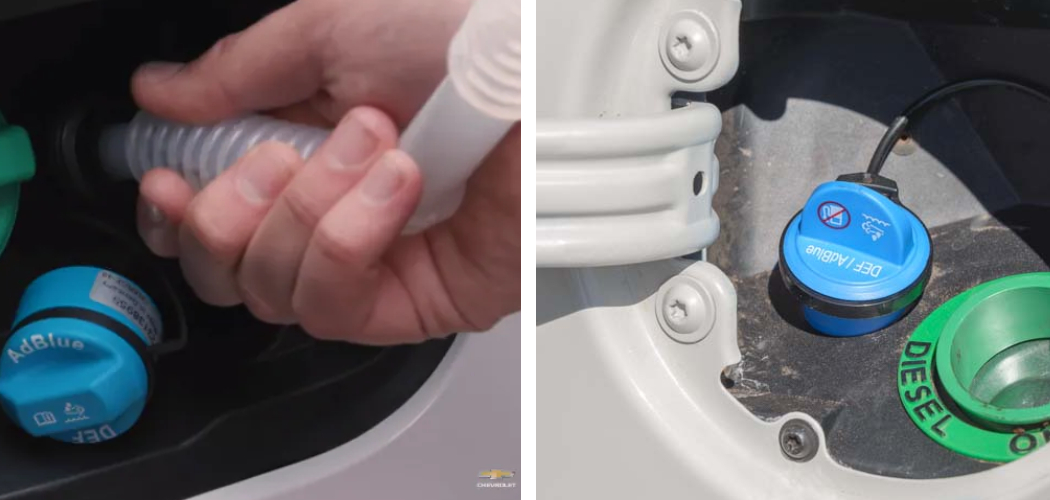Are you wondering how to add diesel exhaust fluid (DEF) to your vehicle? DEF is crucial for reducing emissions and meeting the EPA emission standards. In this guide, we will walk you through the steps of adding diesel exhaust fluid.
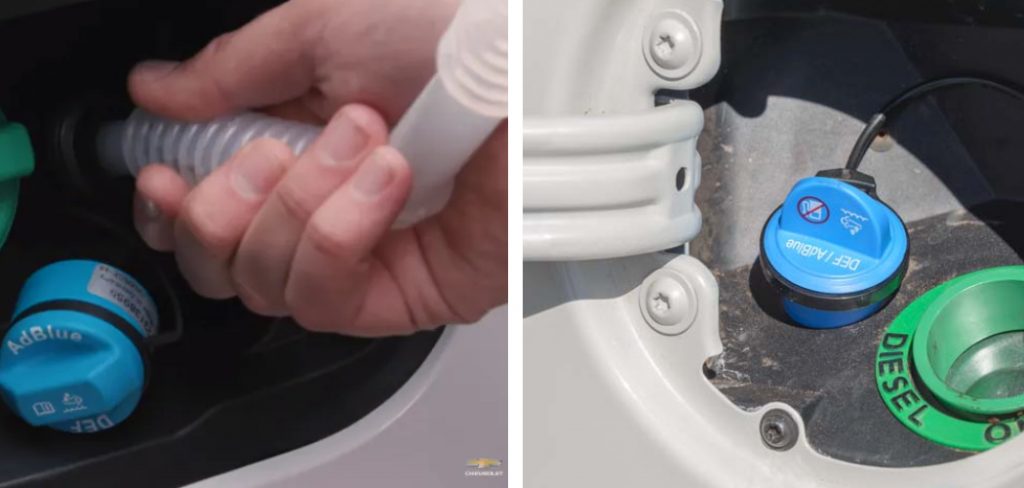
Diesel Exhaust Fluid (DEF) is a key component in keeping modern diesel engines running efficiently and complying with environmental regulations. Made from a mixture of urea and deionized water, DEF breaks down harmful nitrogen oxide emissions into harmless nitrogen and water vapor.
In this section, we’ll guide you through the straightforward process of adding DEF to your vehicle. Understanding when and how to replenish this vital fluid can ensure your diesel engine performs optimally while minimizing its environmental impact.
What is the importance of DEF?
DEF plays a crucial role in reducing the harmful emissions diesel engines produce. It is required to meet the strict emission standards set by the Environmental Protection Agency (EPA). Without DEF, your vehicle cannot pass emissions tests and may face fines for non-compliance.
In addition, using DEF also helps improve fuel efficiency, as it allows the engine to burn fuel more completely. This leads to better engine performance and can even extend the lifespan of your vehicle’s exhaust system.
When Do You Need to Add DEF?
To ensure your vehicle is running at its best, it’s essential to monitor the DEF levels regularly. Most modern diesel vehicles have a DEF gauge on the dashboard that will alert you when the fluid needs to be topped up.
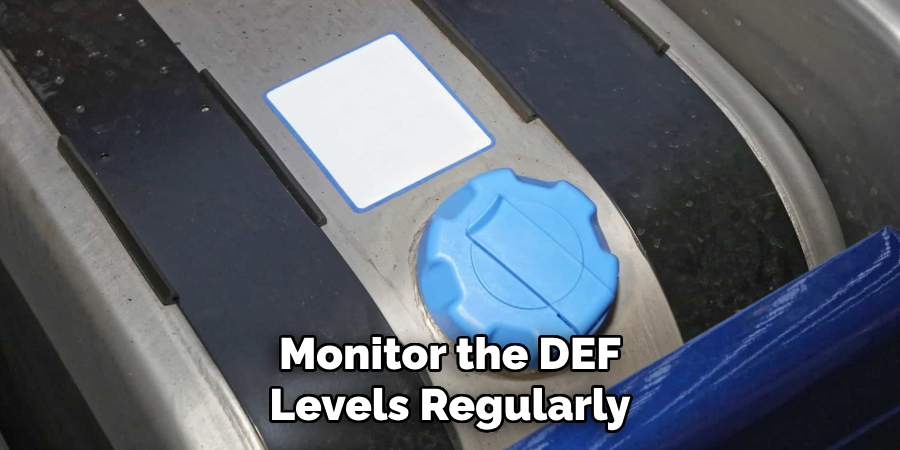
Generally, it is recommended to refill DEF when it reaches 30% capacity or less. You can also check the DEF levels manually by locating the DEF tank and checking the level with a dipstick.
It’s important to note that running out of DEF or ignoring low levels can have serious consequences for your vehicle. Once the DEF tank is empty, the engine will enter a reduced power mode, and if left unchecked, it can eventually prevent the vehicle from starting altogether.
What Tools and Materials Do You Need?
Adding DEF to your vehicle is a simple process that requires minimal tools and materials. You will need:
- DEF fluid (available at most gas stations and auto supply stores)
- A funnel (preferably one specifically designed for DEF)
Now that you have all the necessary tools and materials, follow these steps to add DEF to your vehicle.
10 Easy Steps on How to Add Diesel Exhaust Fluid
Step 1. Locate the DEF Tank:
To begin, locate the DEF tank of your vehicle. This is typically found near the diesel fuel tank but could be elsewhere, depending on your vehicle’s make and model. In some cars, the DEF tank is accessed by opening the fuel door. For others, the tank may have a separate access point. Consult your vehicle’s owner’s manual for the exact location to ensure you add fluid to the correct tank.
Step 2. Ensure the Vehicle is Turned Off:

Before adding DEF, make sure your vehicle’s engine is turned off, and the car is parked on a level surface. This safety precaution is essential to prevent accidents and ensure accurate fluid level checking once you’ve added the DEF. If your vehicle has been running, waiting at least 5 minutes for the engine to cool down before proceeding is recommended.
Step 3. Open the DEF Tank Cap:
Gently twist the cap on the DEF tank to open it. You may need to press down slightly depending on the design of the cap. Be sure to set the lid aside in a clean place to avoid contamination of the DEF system. It’s crucial to ensure that no dirt or debris falls into the tank while it’s open, as this can lead to problems with the DEF system and the vehicle’s emissions control.
Step 4. Prepare the DEF Fluid Bottle:
Before pouring the DEF into the tank, remove the seal from the DEF fluid bottle to ensure it is ready for use. Many DEF bottles come with a nozzle attached, which makes it easier to pour and minimizes spills. If your bottle has a nozzle, attach it securely to the bottle. If not, have your funnel ready for the next step. Always use fresh DEF fluid from a sealed container to avoid contamination.
Step 5. Insert the Funnel or Bottle Nozzle:
Place the funnel firmly in the DEF tank or use the nozzle attached to the DEF fluid bottle. Ensure a tight fit to prevent spills. If your bottle does not have a nozzle and you’re using a funnel, make sure the funnel is clean and designed explicitly for use with DEF to avoid contamination.
Step 6. Pour the DEF into the Tank:
Carefully pour the diesel exhaust fluid into the tank using the funnel or bottle nozzle. Do this slowly to prevent overfilling and spills. It’s essential to pour steadily and avoid splashing as DEF can crystallize and may cause damage if spilled on certain parts of the vehicle. If you’re using a container without a pouring spout, pouring with a steady hand is crucial.
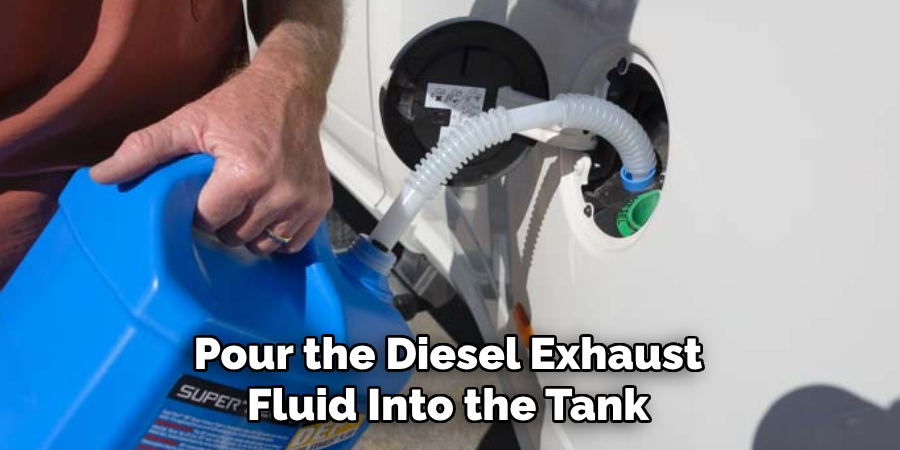
Step 7. Monitor the Fill Level:
As you pour the DEF, watch the tank’s fill level. Most DEF tanks have a maximum fill line or indicator to prevent overfilling. Never fill the tank beyond this point, as the DEF needs room to expand due to temperature changes.
If your tank doesn’t have an indicator, refer to your vehicle’s owner’s manual for the correct fill capacity. Stop pouring once you reach the appropriate level to prevent any issues.
Step 8. Replace the Tank Cap:
Once the DEF has been added to the appropriate level, remove the funnel or bottle nozzle and securely replace the cap on the DEF tank. Make sure the cap is tightened properly to prevent any leakage or contamination. It’s also a good time to wipe away any spills around the area of the DEF tank to prevent crystallization and to keep your vehicle clean.
Step 9. Dispose of the DEF Container Properly:
After replenishing the DEF, properly dispose of the empty DEF fluid container. Remember that DEF is non-toxic; however, proper disposal practices ensure environmental safety. Check your local regulations regarding the disposal of such containers, as many areas offer recycling programs specifically for automotive fluids and their containers.
Step 10. Check for Leaks and Perform a System Check:
Finally, after replacing the cap and dealing with the empty container, start your vehicle to ensure the system recognizes the DEF refill. Your DEF gauge on the dashboard should reflect the new level. Look under the car for any signs of leaks around the DEF tank area.

If everything appears normal, take a short drive to ensure the system is functioning correctly and allow the vehicle’s computer to reset any warning messages related to DEF levels.
By following these simple steps, you can quickly and safely add DEF to your vehicle without any hassle. Regularly checking the DEF level and refilling it when needed will ensure that your vehicle’s emissions control system is functioning correctly and avoid any potential issues or costly repairs in the future.
5 Additional Tips and Tricks
- Check the Display: Many vehicles with diesel engines feature a DEF level display within the on-board diagnostics. Regularly monitor this to determine when to add more fluid without guessing or waiting for a low-level warning.
- Avoid Contaminants: When refilling the DEF, use a clean funnel designated for DEF to avoid contamination. A contaminated DEF can lead to the SCR (Selective Catalytic Reduction) system malfunctions.
- Store Properly: Keep your DEF in a cool, dry place and out of direct sunlight. DEF has a shelf life, and exposure to extreme temperatures or sunlight can degrade its quality.
- No Topping Off: Unlike refueling with diesel, when adding DEF, avoid the temptation to top off. Overfilling can result in spills or system issues since DEF expands when it warms up after the vehicle starts running.
- Be Proactive with Purchasing: Since DEF is required for the vehicle’s operation, purchasing it in advance and keeping an extra bottle in the car is wise. This ensures you’re prepared if you are running low suddenly while on the road.
With these additional tips and tricks, you can ensure your diesel exhaust fluid is adequately managed and used in your vehicle. Regularly monitoring the display, avoiding contaminants, proper storage, not topping off, and being proactive with purchasing are all key factors to keep in mind when dealing with DEF.
In addition, it’s also important to check for any leaks or malfunctions in the DEF
5 Things You Should Avoid When Adding Diesel Exhaust Fluid (DEF)
- Don’t Use Old DEF: Never use DEF that has been sitting for too long or has passed its expiration date. The efficiency of the fluid diminishes over time, which could compromise your vehicle’s emissions standards and engine performance.
- Avoid Cross-Contamination: Ensure that you never use containers or funnels that have been used for other fluids when handling DEF. Even small amounts of oil, fuel, or water can contaminate DEF and damage the SCR system.
- Don’t Ignore Leaks: If you notice your DEF system is leaking, don’t top off the fluid and hope for the best. Leaks can be a sign of larger issues and can lead to bigger problems or failure of the emissions system.
- Only Mix DEF Brands With Checking: While DEF is standardized if you must switch brands, check compatibility. Some brands may add additional ingredients, and although rare, this could affect the SCR system.
- Avoid Pouring DEF into Diesel Tank: This may seem obvious, but always be certain you’re pouring DEF into the designated DEF tank, not the diesel fuel tank. Mistaking the two can result in costly repairs and downtime for the vehicle.
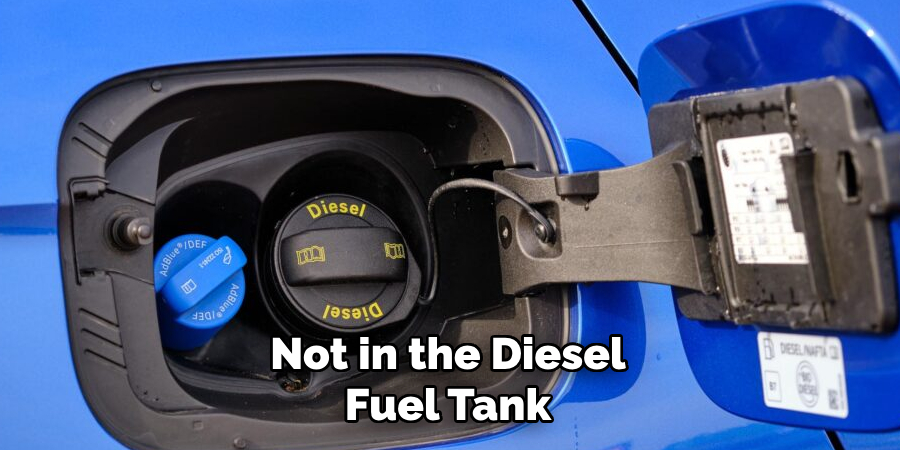
By clearing these common mistakes, you help ensure the optimal performance of your diesel vehicle’s SCR system and adherence to necessary emission standards.
Some Frequently Asked Questions
1. How is Diesel Exhaust Fluid Used?
Diesel Exhaust Fluid (DEF) is used in vehicles with diesel engines as part of the Selective Catalytic Reduction (SCR) process. DEF is injected into the exhaust stream, which converts harmful nitrogen oxides (NOx) into harmless nitrogen gas and water vapor. This process helps reduce emissions and meet various environmental regulations.
The use of DEF has become increasingly crucial as emissions standards become more stringent. It is also key in helping diesel vehicles meet the Environmental Protection Agency’s (EPA) emissions requirements.
In addition, DEF helps prolong the life of various parts and components within the vehicle’s exhaust system by reducing harmful pollutants. Properly using and managing DEF helps ensure optimal performance and longevity of your diesel engine.
2. What Happens if You Don’t Fill Diesel Exhaust Fluid?
If you don’t fill your diesel exhaust fluid (DEF) tank or if it runs dry, your vehicle will not be able to operate correctly. The selective catalytic reduction (SCR) system relies on DEF to convert harmful nitrogen oxides into harmless nitrogen and water vapor.
Without sufficient DEF, the SCR system cannot function correctly, leading to increased emissions and potentially causing damage to your vehicle’s engine. Furthermore, if your DEF tank runs dry while driving, the car may go into “limp” mode or even shut down completely, resulting in costly repairs and downtime.
In addition to potential damage to your vehicle and non-compliance with emissions standards, not filling DEF can result in hefty fines for commercial vehicles. According to the Environmental Protection Agency (EPA), tampering with or removing emissions control equipment, such as the SCR system, can result in fines per vehicle per violation.

Therefore, it is crucial to regularly monitor and refill DEF in your diesel vehicle to ensure proper operation and compliance with emissions regulations. Remember to follow these tips and avoid common mistakes when handling DEF to maintain the performance and longevity of your vehicle.
Overall, properly managing and using DEF is essential for the safe and efficient operation of diesel vehicles while also contributing to reducing harmful environmental emissions.
3. What is the Difference Between Diesel and Diesel Exhaust Fluid?
Diesel exhaust fluid (DEF) is a non-toxic solution comprising 32.5% urea and 67.5% deionized water. It is used in diesel vehicles with selective catalytic reduction (SCR) systems to convert harmful nitrogen oxides into harmless gases. On the other hand, diesel fuel is a petroleum-based product that powers the engine of diesel vehicles.
The main difference between the two is their purpose and composition. Diesel fuel is used as an energy source for the engine, while DEF helps reduce emissions by breaking down harmful pollutants. Furthermore, diesel fuel is stored in a dedicated tank within the vehicle, whereas DEF is stored in a separate tank and injected into the exhaust system when needed.
In summary, diesel fuel is used to power the engine, while DEF reduces harmful emissions in diesel vehicles equipped with SCR systems. Both are essential components of a diesel vehicle and should be appropriately managed to ensure optimal performance and compliance with emissions regulations.
So, it’s essential to understand the difference between them and use them correctly when refilling your vehicle. Keep these tips in mind to ensure the proper use of diesel exhaust fluid and keep your vehicle running smoothly. Always check your DEF levels regularly, purchase from a reputable source, and follow proper handling procedures for optimal performance and emission control.
4. Is Diesel Exhaust Fluid Coolant?
No, diesel exhaust fluid (DEF) is not coolant. DEF is a non-toxic solution comprising 32.5% urea and 67.5% deionized water that helps reduce harmful emissions in diesel vehicles equipped with selective catalytic reduction (SCR) systems.
Conversely, coolant is a liquid mixture used to maintain engine temperature and prevent overheating. It is typically a mix of water, ethylene glycol, or propylene glycol, sometimes with additional corrosion inhibitors.
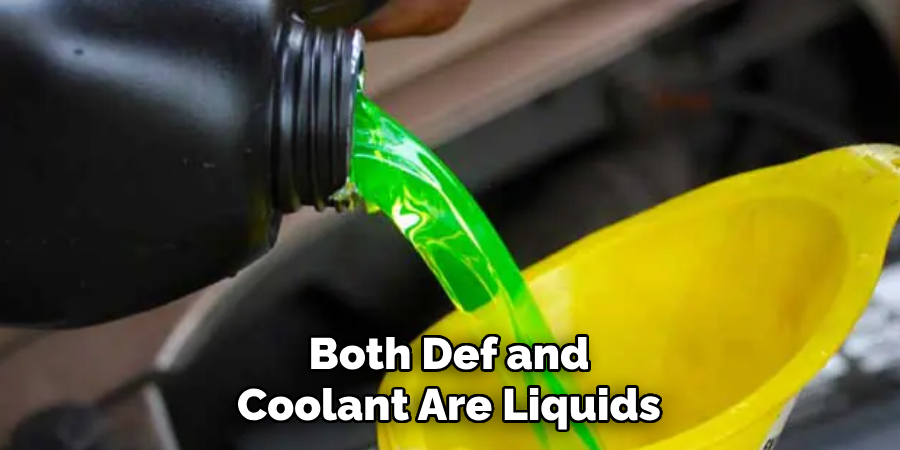
Although both DEF and coolant are liquids used in diesel vehicles, they serve different purposes and should not be confused with each other. Mixing DEF into the engine coolant can damage the vehicle’s engine and exhaust system.
Therefore, it is essential to use and store DEF and coolant separately and follow proper handling procedures. Always consult your owner’s manual or a professional mechanic for specific instructions on managing these fluids in your diesel vehicle.
Conclusion
How to add diesel exhaust fluid to your vehicle is a simple but critical maintenance task that helps keep your diesel engine running cleanly and efficiently.
To ensure the proper addition of DEF, follow these general steps: Firstly, locate the DEF tank, which is often marked with a blue cap and typically found near the fuel filler, under the hood, or in the trunk area. Use only DEF that meets the ISO 22241 standard to avoid contamination or potential damage.
Unscrew the cap, and carefully pour the DEF into the tank, using a funnel if necessary to prevent spills. Be mindful not to overfill the tank, as DEF can expand when temperatures change. After filling, securely replace the cap and dispose of any empty DEF containers properly.
By adhering to these guidelines and routinely checking your DEF levels, you can contribute to the reduction of nitrogen oxide emissions and maintain your vehicle’s compliance with environmental standards. It’s not just about keeping your engine running—it’s about contributing to a clearer, more sustainable environment for all.

